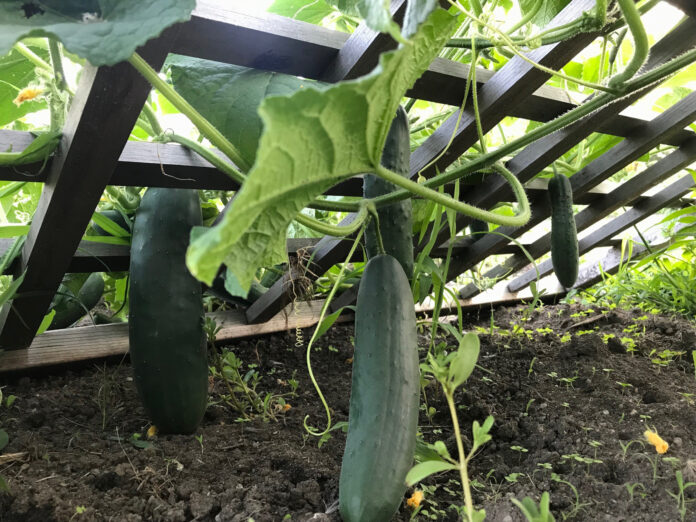by Mark and Ben Cullen
“Look up. Look waaaayyy up” the Friendly Giant used to say at the opening of his CBC tv show.
Not bad advice for gardeners. After all, real estate has shot up in value and every square foot of space in your yard suddenly equals (more) money in the bank.
How to make the best use of your garden space? The obvious answer is to grow vines, which produce shade, and flower vertically. But what if your vines also produce food? That would make you a real estate, investment, foody genius, right?
Here are our top eight picks of food producing vines:
- Runner beans. Ok, we hate eating them, but you cannot deny their ability to cover vertical space fast. They produce an abundance of attractive red flowers, not to mention pollinators including bumblebees. If you happen to like eating the long green bean, so much the better. For added interest, look for purple podded stringless beans, which sound a bit more tempting to us. Minimum 6 hours of sun.
- Cucumbers. Not all cucumbers climb, but most do. Avoid the newer varieties that clump and are hybridized for use in containers or in a patio pot. Mark grows his English long cucumbers over an A-frame in this veggie garden, but you can train them up a trellis just as easily. The cucumber fruit hangs as you might imagine it in the hanging gardens of Babylon. A crop fit for royalty, especially the burpless varieties: more civilized. Requires full sun.
- Squash. Members of the cucumber family (or are cucumbers members of the squash family?). Sow the seeds for autumn squash now in a sunny, hot position. Give their roots lots of space, a square metre or so. Enrich the soil with plenty of compost and give them support using a trellis or series of string attached to a wall or fence. Be prepared to create a hammock for the heavy fruit when it matures, using thin fabric or a used bra otherwise the squash may fall off the vine prematurely.
- Gourds. Italian gourds are quite edible while ornamental gourds are, well, ornamental. Both climb up a wall, fence, or trellis nicely and produce a dramatic display of hanging fruit later in the season. Grow from seed in a sunny position now.
- Kiwi. We mentioned these a couple weeks ago, as a novelty plant, but they are so easy and fast to grow that they make a great addition to both the fruit and ornamental garden. Be sure to plant both male and female specimens as they need cross pollination to produce sweet fruit about the size of your thumb, from the knuckle up.
- Hops. The flowers of hops are used to make a sleep-inducing tea or, of course, beer. Either way, they grow fast and twine up most anything vertical. A bit invasive, so keep their growth in check by pruning heavily or planting in a container. Young leaves of hops can be steamed as a veggie dish.
- Tomatoes. Ever notice how we say “tomato vine” but grow them on a bush? There are varieties that grow vertically very nicely. Look for indeterminate varieties. Mark’s favourites are Brandy Wine, Sweet One Million (cherry) and Yellow Pear, all growing in his garden. Tie them up securely as they become top heavy when they start to fruit in early August. Lots of sun and heat.
- Peas. Garden peas need support to perform best so why not train them up a trellis, wall, or fence rather than in the middle of your garden? They benefit from the air that circulates around them while off the ground and they are much easier to pick. Minimum 6 hours sun each day.
Come to think of it, all fruiting vines benefit from the additional exposure to the sun, the wind moving through their foliage and you benefit from the accessibility of fruit produced off the ground. Not to mention the most efficient use of your garden space. Genius.
Mark Cullen is an expert gardener, author, broadcaster, tree advocate and Member of the Order of Canada. His son Ben is a fourth-generation urban gardener and graduate of University of Guelph and Dalhousie University in Halifax. Follow them at markcullen.com, @markcullengardening, and on Facebook.


